
Frequently
Asked Questions
Q: Is there an introduction
to QCUIAG for beginners?
A: Yes, Jan Timmermans has
written such an introductio here.
Also see What is QCUIAG?.
Q: What are stacking, averaging,
summing, and off chip integration, and how are these things significant to
QCUIAG imaging methods?
A: by
Bev Ewen-Smith
Q: Will my camera take long
exposures?
A: Currently, the
ONLY webcam that is able to take true long exposures without
significant modification is the greyscale CONNECTIX QuickCam.
The only HARDWARE modification
required is the cutting of a single wire. Long exposures
are achieved by the use of special software that can be located in the Research
section of this website. It is expected that software may be written to include
the Connectix Color QuickCam and the Connectix Color QuickCam 2 in the future.
It appears to be impossible to produce software that will allow long exposures
in any other QuickCam or other webcam. This is due to the degree of control
over the camera that is present in firmware in these cameras and not available
for external software control. Hardware modification would be required to
achieve this
HOWEVER, SEE
GROUND-BREAKING PROGRESS BEING MADE
IN HARDWARE MODIFICATIONS TO ALLOW LONG EXPOSURES
IN OTHER VIDEO CAMERAS.
A number of regular digital cameras such as the Casio QV8000SX
have the ability to take exposures of the order of up to a minute or even
longer. The owner of a digital camera should refer to the instruction manual.
It is likely that regular digital cameras will be increasingly used
for astronomical imaging in the future. (S.J.
Wainwright)
Q: Which other cameras can
be modified to allow long exposures?
A: To date, the following
cameras have been modified for long exposures:
Please note that many camera models
have similar names, but totally different circuitry. Only the exact models
mentioned below have been found to be modifiable for long exposures.
Using variations of the Stephen Chambers
SC modification
Webcams tend to have a short production run and so quickly become discontinued.
However, they can frequently be found for sale at a reasonable price on web
auctions such as eBay.
Q: Is there any other way
of getting long exposures from my video or webcam?
A: Yes. Members of this
group have developed a method called Off
Chip Video Integration which allows the synthesis of long exposures
by adding together large numbers of shorter exposures. Video Integration software
can be downloaded for Linux or Windows via the Research
and Download page of this website. See the results of Off Chip Video Integration
on this website.
Results obtained by this method can be found on the pages of
J. Liesmann and S.J.
Wainwright on this website (S.J. Wainwright)
Q: Are there any image browsers
that will display FITs files ?
A: XnView
is a good browser capable of displaying many image formats, including FITs.
This software is freeware.
Q: What is the best free
image processing software for Windows ?
A: The programs
below are very good freeware Fits viewing and processing packages
1) An excellent program is
The
Gimp. for many images. This package is originally from the Linux
stable. It has been ported over into Windows and has been described as 'The
Photoshop of the Linux world'. The reasons why I consider it to be one of
the best for astronomical image processing are:
Q: Is there any image stacking
software for the Macintosh?
A: Yes, an Image
stacker by Keith Wiley
Q: Will
a B/W Connectix QuickCam for a Mac work with a PC ?
A: No.
(S.J. Wainwright)
Q: Is there an FAQ for the
COAA AstroVideo Video Integration software ?
A: Yes, here you will find
the AstroVideo FAQ
Q: How can I connect my
webcam or video security camera to my telescope ?
A: In the Research
and Downloads section of this website you will find various methods of
adapting and mounting cameras for astronomical use. However, Steven Mogg is
producing high quality, Low cost 1.25 inch adapters that will allow the connection
of a webcam (or many board video cameras) to the telescope. Steven also
produces an adapter with a C thread that will allow a surveillance camera
to be telescope-mounted when it's lens is removed.
Steven Mogg's webcam adapter
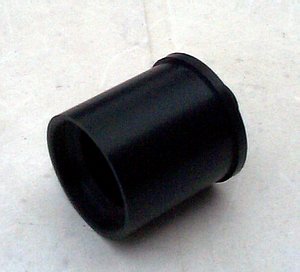
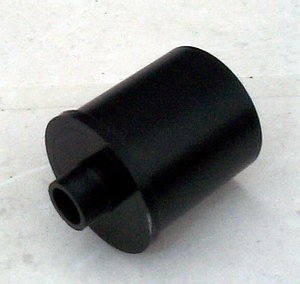
Visit Steven's website
for more information
(S.J. Wainwright)
Q: Is there a manufacturer
of webcam adapters in the UK?
A: Yes: Astroparts
are a source of high quality anodised aluminium webcam adapters.
An Astroparts extender tube to double
the length of the adapter, allowing sufficient out focus for fast refractors.
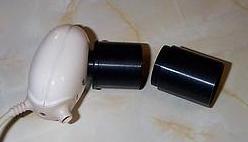
(S.J. Wainwright)
Q: Which is the best video
security camera for me to buy for astronomical imaging?
A: It
depends whether you intend to do planetary/Lunar imaging or whether you wish
to try deep sky imaging. An 0.5 lux camera will be able to capture good images
of the planets and the Moon with many telescopes. If you wish to try deep
sky imaging however, you must use a fast scope and a very sensitive video
camera. Good results on the brighter deep sky objects have been produced with
cameras rated at 0.02 lux or less (some cameras are rated as low as 0.00015
lux) and fast telescopes (say f/5) of reasonable aperture (say >8 inches),
and using Video Integration.
Currently, the
best camera that I have tested is the Mintron
12V1C-EX from Lechner
TV. This camera has the ability to integrate up to 128 video frames
into its own memory whilst outputting a continuous composite video signal
which updates up to every 2560ms. This means that it is actually possible
to see clearly on the video screen, objects such a M57, globular clusters,
M82 etc if the camera is used in conjunction with a fast scope of reasonable
aperture. For example, I was able to see Comet A2 Linear very clearly with
this camera and a 250mm f/4.8 Newtonian. This camera is ideal for public demonstrations
as it is possible to show people deep sky objects, live on a video monitor.
In conjunction with video-integration software such as AstroVideo from
COAA, this camera is very good for imaging deep sky objects by video.
 (S.J.
Wainwright)
(S.J.
Wainwright)
Q: Which is the best webcam
for me to buy for astronomical imaging?
A: Few people are owners
of a wide range of webcams adapted for astronomical imaging, so statements
about which is best should be viewed with caution. However, the best way to
make your own decision is to browse this website and to examine the results
produced by different members with different cameras. However, be sure to
take note of the telescope with which the camera has been used, as clearly,
this will be a strong determinant of the quality of the results. Currently,
the Phillips Vesta series and the ToUcam
seem to be the most favoured webcams for lunar and planetary imaging. Moreover,
now that hardware modifications will allow this family of CCD based webcams
to be used for deep sky imaging as well, these cameras have to be the current
favourites. However, do check that the camera
you are interested in, in this family is CCD based, not CMOS based..(S.J.
Wainwright)
Q: Should
I remove the IR cut filter from my webcam ?
A: Only if
you intend to attempt to image deep sky objects. The IR cut filter blocks
the Infra Red part of the spectrum and so effectively reduces the light sensitivity
of the camera. However, if the IR cut filter is removed, the colour balance
of the resulting images will be upset and less than true colour images will
result. Not all webcams have effective IR cut filters. The B/W Connectix QuickCam
is an example of a webcam with a true IR cut filter with very little transmission
in the Infra Red. (S.J. Wainwright)
Q: Should I air-cool my
modified webcam ?
A: Only if: a)
You intend to image deep sky objects. b) Your
camera generates significant amounts of heat. The aim
of air cooling is slightly different from the aim of peltier cooling. Air
cooling is to remove excess heat generated by the camera itself (some cameras
get quite hot) to reduce the thermal noise resulting from this heat. This
is only important if you are imaging dim objects and in particular if you
are subtracting dark frames. Peltier cooling is to reduce the temperature
of the CCD chip itself, usually to 20-30 degrees Celsius below ambient. This
effectively eliminates thermal electrons due to the ambient conditions and
allows long exposures to result mainly from photon generated electrons, rather
than thermally generated electrons. Nontheless, good results can be obtained
with long exposures from totally uncooled cameras. The B/W Connectix QuickCam,
which, with Dave Allmon's QCV2 software, can take long exposures, only has
a 6 bit ADC, which reduces the effectiveness of Peltier cooling. (S.J.
Wainwright)
Q: Should I Peltier-cool
the CCD in my converted webcam ?
A: Only if the camera is
capable of taking true long exposures. Before you set about Peltier -cooling
your camera, test its uncooled capabilities. (S.J. Wainwright)
Q: How can I make an eyepiece
parfocal with my video surveillance camera or webcam ?
A: A parfocal ring can be
improvised as shown elsewhere
on this website, or better still, use a Steven Mogg low cost parfocal ring:
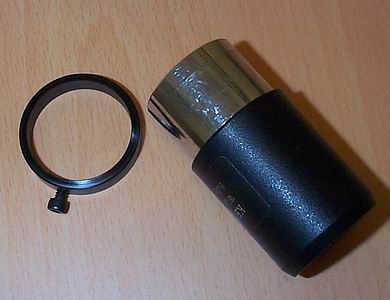
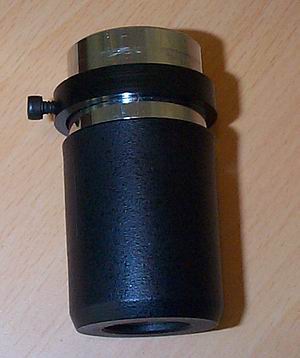
The camera is pushed fully into the focusser and the starfield
focussed until the stars are sharp points of light. Then the camera is removed
and the eyepiece with a loosely fitting parfocal ring is pushed into the focusser
until the image is sharp. Then the screw on the parfocal ring is tightened
so that the eyepiece cannot slide further into the focusser. The eyepiece
is now parfocal with the camera. Thsi will greatly facilitate focussing in
the future.
Visit Steven's website
for more information (S.J. Wainwright)
Q: Can I reduce the focal
length of my system to make it faster?
A: Focal reducers can be
purchased and are usually quite expensive. However, Steven Mogg has produced
a low cost focal reducer lens that will screw into the filter thread on the
front of a Standard 1.25 inch scope adapter or a Mogg adapter. Preliminary
tests show that good images can be produced with this focal reducer. More
extensive tests are underway.
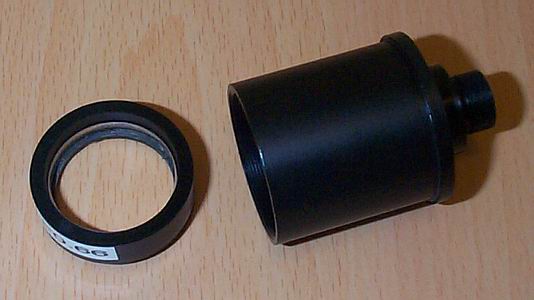
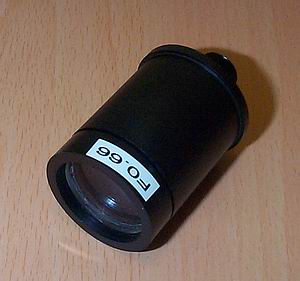
Visit Steven's website
for more information (S.J. Wainwright)
More QCUIAG
FAQ on Colin Webb's FAQ Page

 and other advantages.
and other advantages.
